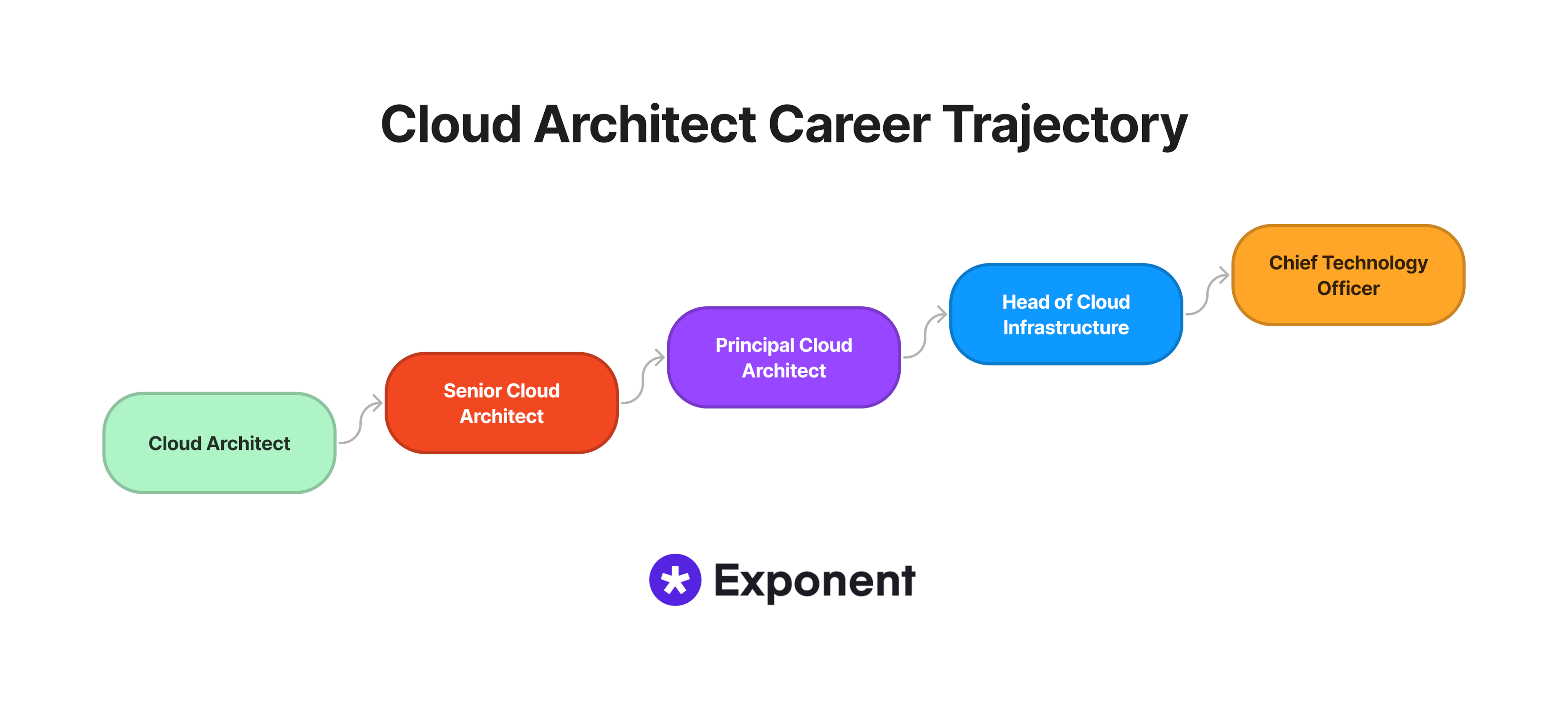How to Become a Cloud Architect: The Ultimate Career Path Guide
Solutions Architect Anthony Pellegrino • Last updated
Anthony Pellegrino • Last updated 
Are you interested in jumping into the exciting role of cloud architect? We wouldn't blame you given the high salaries and fascinating responsibilities.
However, the role of a cloud architect is not an entry-level position. You will need extensive technical experience to qualify for most professional cloud architect positions.
So, how do you become a cloud architect then?
After all that hard work, where do you go once you've become a cloud architect?
There's no set path or career trajectory (besides a background in computer science, of course). However, you can take many directions to become a cloud architect and then later on in your career.
That's why we wrote this article, to help give you a better sense of the cloud architect career path in 2022.
So let's get to it!
What Is a Cloud Architect?

Before we get into the nitty-gritty, we should first define the role of cloud architects. A cloud architect is technically a subset of a solutions architect roles responsible for designing and implementing technical solutions to an organization's business problems.
Cloud architects, however, are responsible for using cloud computing technologies to engineer these solutions.
Typically, cloud architects are responsible for designing and building the cloud technologies of their firms. They are also expected to play a central role in developing and establishing a company's cloud computing strategy.
To learn more about the role of a cloud architect, be sure to check out our article below:

In recent years, cloud computing has taken off rapidly. Now, you'd be hardpressed to find any company, product, service, or digital good that is not, in some way, reliant on a cloud environment of some kind.
The field of cloud computing, given the widespread adoption of cloud services, is exceptionally diverse. As a result, different cloud architects could be tasked with various things, even at the same company.
Each cloud architect is expected to wear many hats and use various technical skills.
Because of this, there are many potential paths to becoming a professional cloud architect. By that same token, there are many paths after becoming a cloud architect.
So, let's dive deeper into a cloud architect's career paths and trajectories without further adieu.
The Ultimate Guide to the Cloud Architect Career Path

The Software Developer Path for Cloud Architects
Many cloud architects began their professional careers as software developers or engineers. However, cloud computing is a very technical career that requires many different engineering-related skills, so the software developer career path naturally leads to it.
Software Developer

Software developers or engineers are tasked with using their knowledge of coding and programming languages to develop software for their firms or for clients.
Typically, they work in engineering teams alongside other developers and engineering managers. Their responsibilities include examining and altering existing software while designing and building. Testing programs to meet user needs using programming languages such as C++, Java, and Python.
While many cloud architects will likely not do that much coding in their roles (although they still could), the software developer career path can provide the technical foundation necessary for success in a cloud computing job.
The typical salary for a software developer is $106,220/year.
DevOps Engineer

After working as a software developer or engineer for some time, you can find yourself being promoted to DevOps (Development Operations) Engineer.
The role of a DevOps engineer, as the name suggests, is a mixture of engineering, development, and operations. In a sense, DevOps engineers are responsible for developing systems and procedures to help engineering teams deliver software faster, more efficiently, and at higher and higher quality.
A DevOps engineer will work cross-functionally across many teams, and departments like cloud architects routinely do.
The DevOps position shares many aspects with the work of a cloud architect, especially when it comes to developing systems. Therefore, it can be considered a critical foundational stepping stone into a cloud architecture career.
The typical salary for a DevOps engineer is $116,657/year.
The Network Administrator Path to Cloud Architect
Besides a start in software engineering, the other typical career start for a cloud architect is first working as a network or systems administrator.
Cloud technology, by its nature, relies entirely on networking tech. Therefore, every cloud architect will need an understanding of networking fundamentals, like TCP/IP, IP addresses, HTTP, DNS, etc.
Network Administrator

Network administrators are those individuals that are tasked with monitoring and supervising a company's computer systems or database networks. Maintenance and security are the names of the game for network administrators.
In many cases, they are tasked with:
- Working alongside other IT or engineering departments to pinpoint network or computer system needs or potential problems,
- Install new networking hardware or software,
This is another common career path for cloud architects because of how naturally reliant cloud architecture is on an organization's networks. Even if you did not begin your cloud architecture career as a network tech or specialist, you still need a solid grasp of networking technologies for the role.
Like a previous position in DevOps, the Network Administrator role is an important (possibly the most important) foundational stepping stone into a cloud architecture career.
The typical salary for a network administrator is $86,943/year.
System Administrator

System administrators (or sysadmins) are similar to network administrators. In some organizations, network administrators are promoted into the role. In others, a sysadmin may, more or less, be equivalent to a network administrator.
Regardless, sysadmins are responsible for ensuring an organization's computer systems function correctly and efficiently and are designed to adequately meet the company's needs.
This may mean that system administrators have many of the same responsibilities that network administrators do. However, the role of a system administrator is broader in its scope. Network administrators may be more focused on just network-related tech and responsibilities.
A system administrator's job responsibilities will likely include:
- Handling Windows, Linux, or Mac systems,
- Upgrading, installing, and setting up software and computer hardware for an organization's computer systems,
- Troubleshooting and providing tech support for an organization's computer systems,
- Creating and managing system permissions,
- Monitoring the security of a computer system,
- Providing maintenance for a computer system,
The typical salary for a system administrator is $89,610/year.
The Database Architect Path to Cloud Architect
Finally, the last typical career start we'll detail in our article is that of the database administrator and architect. Database administrators may begin their careers as system engineers and work their way into the role.
Database Architect

A database architect is a role that is tasked with designing, building, and maintaining the databases that an organization relies on.
This is a very data-heavy role, requiring the assistance of database administrators and data analysts to build the most efficient and problem-free databases.
As you can imagine, the position of a database architect is not far from that of a cloud architect. Not only do both roles design and build systems for their organizations, but both are also reliant on data, just in different ways.
Because of the nature of cloud computing (storing data in the cloud), spending some time as a database administrator and architect earlier in your career is a great and straightforward stepping stone into the cloud architect position.
The typical salary for a database architect is $120,883/year.

Complete Solutions Architect Interview Prep Course
Our solution architect interview course helps you review the most important system design principles and leadership principles to ace your solution architect interview, with detailed questions and mock interviews.
The Cloud Architect Career Trajectory

As you can see, there's no set path to becoming a cloud architect. Nor is there a set path forward after you've become one. However, many exciting opportunities could come your way as a cloud architect.
However, suppose you want to continue your career in cloud computing architecture. In that case, your career trajectory could look something like this:

Senior Cloud Architect
As you can imagine, the role of a senior cloud architect does not differ substantially from that of a cloud architect. Nevertheless, it is likely the first promotion that a cloud architect will receive.
However, a senior cloud architect would likely be expected to take more of a leadership role in their cloud computing teams, help train new members of the group, or be the ones expected to meet with members of upper management or other departments.
The typical salary for senior cloud architects is $143,408/year.
Principal Cloud Architect
After some time as a cloud architect or senior cloud architect, you can be promoted to that of principal cloud architect. These individuals are considered the leading voices of the cloud computing architecture team. They will almost always be tasked with developing some of the most challenging yet critical cloud computing solutions in their companies.
Whereas senior cloud architects may have people management duties, like other "principal" positions, principal cloud architects will not act as managers. Instead, they are the most senior and significant individual contributors to the cloud computing team.
As a result, it may require up to 10 or more years of working with cloud environments to become a principal cloud architect.
The typical salary for principal cloud architects is $166,419/year.
Director/Head of Cloud
After becoming a principal cloud architect, it is possible to find yourself at the end of your career path. After all, the job responsibilities, the salary, and the length of time it takes to get there may make most people feel content.
However, it is still possible to move up the career ladder. It just may be a little more challenging from here on out.
That's because the next rungs of the ladder are moving into upper or executive-level management.
This means becoming the Director or Head of Cloud for cloud architects.
As you can imagine, these individuals are responsible for defining the cloud computing strategy, direction, architecture, and standards for their entire organization and the entire cloud team.
Given that Directors of Cloud Infrastructure are on the executive team, they will report directly to the CEO or CTO.
It may take 15 - 20 years to accumulate the experience to become the Director/Head of Cloud Infrastructure and require significant knowledge of cloud technology.
The average salary of a Director of Cloud Infrastructure is $179,579/year.
Chief Technology Officer
Truth be told, this position does not require much introduction. So, if you work in tech, you surely know what a Chief Technology Officer is.
This is probably the highest position that most cloud architects can aspire to if a career in the C-Suite is what they desire.
As the name suggests, the CTO is the chief executive tasked with overseeing and managing a company's technological needs and its research and development.
The CEO of technology at the firm, essentially. As a member of the C-Suite, CTOs will work alongside and report directly to the CEO. In addition, they may be expected to regularly interface with the Board of Directors or major investors/shareholders.
While this role is obviously technical, it's improbable that a CTO would get their hands dirty. For instance, they would likely not perform any hands-on tech work, such as coding. This may not be the case at startup or early-stage companies, however.
Enjoy your work as a cloud architect. You may not necessarily enjoy the role of CTO, even if the opportunity was available to you. Sure, the pay would likely be better than the principal cloud architect role, but CTO is a C-Suite job. This means it's a more business-oriented and big-picture role. CTOs would likely be telling high-level engineering staff what they should be doing or focusing on rather than doing it themselves.
Nevertheless, the CTO position is the end of the cloud architect career path.
The average salary for a Chief Technology Officer is $193,952.
More Resources
Needless to say, becoming a cloud architect will first require acing your interviews. And there's no better way to prepare for your upcoming Cloud Architect interviews than to get out there and practice. Here are some resources that could be helpful in your preparation:
👯♂️ Practice your behavioral and system design skills with our interview practice tool.
👨🎓 Take our complete System Design interview course.
🖊️ Software engineering interview cheat sheet
Good luck with your interview preparation journey!
Learn everything you need to ace your solutions architect interviews.
Exponent is the fastest-growing tech interview prep platform. Get free interview guides, insider tips, and courses.
Create your free account